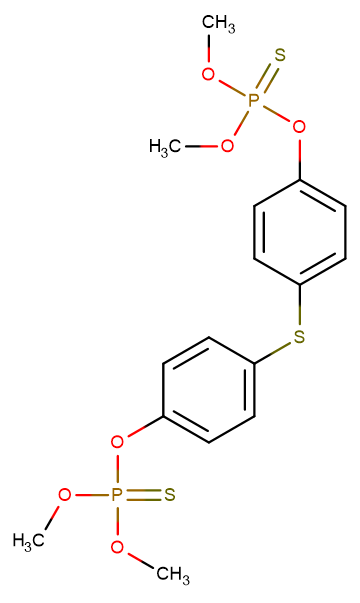
Temephos
CAS No. 3383-96-8
Temephos ( Temefos; Abate; Bithion; Lyphor; Procida )
Catalog No. M14146 CAS No. 3383-96-8
Temefos is an organophosphate larvicide, used to treat water infested with disease-carrying insects including mosquitoes, midges, and black fly larvae.
Purity : >98%(HPLC)
 COA
COA
 Datasheet
Datasheet
 HNMR
HNMR
 HPLC
HPLC
 MSDS
MSDS
 Handing Instructions
Handing Instructions
| Size | Price / USD | Stock | Quantity |
| 25MG | 38 | In Stock |


|
| 100MG | Get Quote | In Stock |


|
| 200MG | Get Quote | In Stock |


|
| 500MG | Get Quote | In Stock |


|
| 1G | Get Quote | In Stock |


|
Biological Information
-
Product NameTemephos
-
NoteResearch use only, not for human use.
-
Brief DescriptionTemefos is an organophosphate larvicide, used to treat water infested with disease-carrying insects including mosquitoes, midges, and black fly larvae.
-
DescriptionTemefos is an organophosphate larvicide, used to treat water infested with disease-carrying insects including mosquitoes, midges, and black fly larvae. Temefos affects the central nervous system through inhibition of cholinesterase, results in death before reaching the adult stage.
-
SynonymsTemefos; Abate; Bithion; Lyphor; Procida
-
PathwayEndocrinology/Hormones
-
TargetAChR
-
RecptorAChR
-
Research AreaInfection
-
Indication——
Chemical Information
-
CAS Number3383-96-8
-
Formula Weight466.47
-
Molecular FormulaC16H20O6P2S3
-
Purity>98%(HPLC)
-
SolubilitySoluble in DMSO
-
SMILESS=P(OC)(OC)OC1=CC=C(SC2=CC=C(OP(OC)(OC)=S)C=C2)C=C1
-
Chemical NamePhosphorothioic acid, O,O'-(thiodi-4,1-phenylene) O,O,O',O'-tetramethyl este
Shipping & Storage Information
-
Storage(-20℃)
-
ShippingWith Ice Pack
-
Stability≥ 2 years
Reference
1.Lima JB, et al. Am J Trop Med Hyg. 2003 Mar;68(3):329-33.
molnova catalog


related products
-
Ribavirin
Ribavirin is a nucleoside antimetabolite antiviral agent that blocks nucleic acid synthesis and is used against both RNA and DNA viruses.
-
Nicotine
Nicotine is the primary pharmacologic component of tobacco. It acts on nicotinic acetylcholine receptors (nAChRs) in the peripheral nervous system (autonomic ganglia and adrenal medulla neuromuscular junction) and the central nervous system (CNS).
-
Lobeline hydrochlori...
Lobeline hydrochloride, a nicotinic receptor agonist, acting as a potent antagonist at both α3β2 and α4β2 neuronal nicotinic receptor subtypes.



 Cart
Cart
 sales@molnova.com
sales@molnova.com


